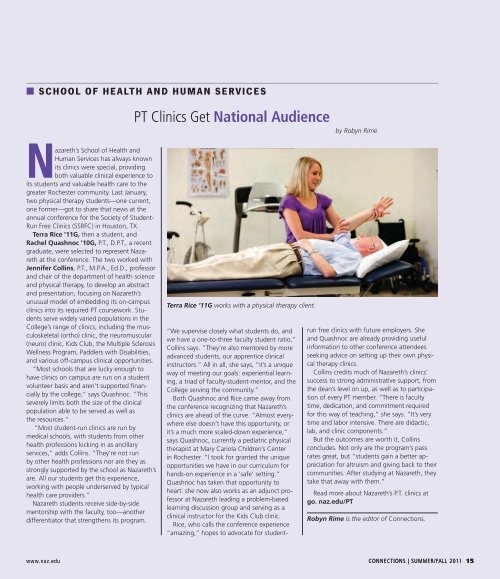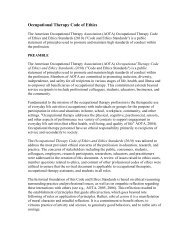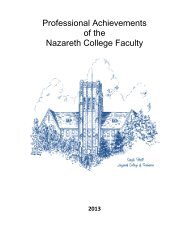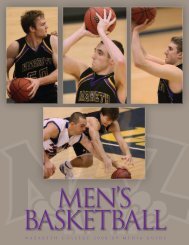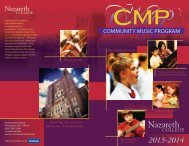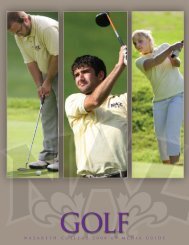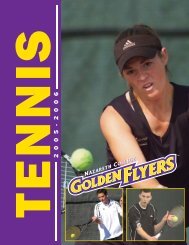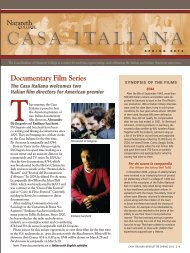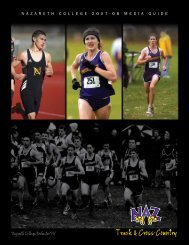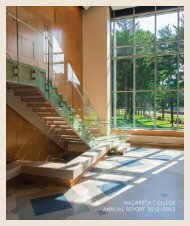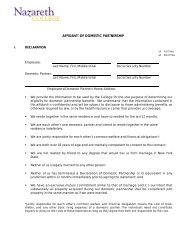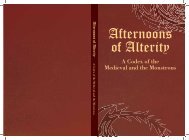SummEr/FAll 2011 - Nazareth College
SummEr/FAll 2011 - Nazareth College
SummEr/FAll 2011 - Nazareth College
Create successful ePaper yourself
Turn your PDF publications into a flip-book with our unique Google optimized e-Paper software.
n school of health and human services<br />
PT Clinics Get National Audience<br />
by Robyn Rime<br />
<strong>Nazareth</strong>’s School of Health and<br />
Human Services has always known<br />
its clinics were special, providing<br />
both valuable clinical experience to<br />
its students and valuable health care to the<br />
greater Rochester community. Last January,<br />
two physical therapy students—one current,<br />
one former—got to share that news at the<br />
annual conference for the Society of Student-<br />
Run Free Clinics (SSRFC) in Houston, TX.<br />
Terra Rice ’11G, then a student, and<br />
Rachel Quashnoc ’10G, P.T., D.P.T., a recent<br />
graduate, were selected to represent <strong>Nazareth</strong><br />
at the conference. The two worked with<br />
Jennifer Collins, P.T., M.P.A., Ed.D., professor<br />
and chair of the department of health science<br />
and physical therapy, to develop an abstract<br />
and presentation, focusing on <strong>Nazareth</strong>’s<br />
unusual model of embedding its on-campus<br />
clinics into its required PT coursework. Students<br />
serve widely varied populations in the<br />
<strong>College</strong>’s range of clinics, including the musculoskeletal<br />
(ortho) clinic, the neuromuscular<br />
(neuro) clinic, Kids Club, the Multiple Sclerosis<br />
Wellness Program, Paddlers with Disabilities,<br />
and various off-campus clinical opportunities.<br />
“Most schools that are lucky enough to<br />
have clinics on campus are run on a student<br />
volunteer basis and aren’t supported financially<br />
by the college,” says Quashnoc. “This<br />
severely limits both the size of the clinical<br />
population able to be served as well as<br />
the resources.”<br />
“Most student-run clinics are run by<br />
medical schools, with students from other<br />
health professions kicking in as ancillary<br />
services,” adds Collins. “They’re not run<br />
by other health professions nor are they as<br />
strongly supported by the school as <strong>Nazareth</strong>’s<br />
are. All our students get this experience,<br />
working with people underserved by typical<br />
health care providers.”<br />
<strong>Nazareth</strong> students receive side-by-side<br />
mentorship with the faculty, too—another<br />
differentiator that strengthens its program.<br />
Terra Rice ’11G works with a physical therapy client.<br />
“We supervise closely what students do, and<br />
we have a one-to-three faculty student ratio,”<br />
Collins says. “They’re also mentored by more<br />
advanced students, our apprentice clinical<br />
instructors.” All in all, she says, “it’s a unique<br />
way of meeting our goals: experiential learning,<br />
a triad of faculty-student-mentor, and the<br />
<strong>College</strong> serving the community.”<br />
Both Quashnoc and Rice came away from<br />
the conference recognizing that <strong>Nazareth</strong>’s<br />
clinics are ahead of the curve. “Almost everywhere<br />
else doesn’t have this opportunity, or<br />
it’s a much more scaled-down experience,”<br />
says Quashnoc, currently a pediatric physical<br />
therapist at Mary Cariola Children’s Center<br />
in Rochester. “I took for granted the unique<br />
opportunities we have in our curriculum for<br />
hands-on experience in a ‘safe’ setting.”<br />
Quashnoc has taken that opportunity to<br />
heart: she now also works as an adjunct professor<br />
at <strong>Nazareth</strong> leading a problem-based<br />
learning discussion group and serving as a<br />
clinical instructor for the Kids Club clinic.<br />
Rice, who calls the conference experience<br />
“amazing,” hopes to advocate for studentrun<br />
free clinics with future employers. She<br />
and Quashnoc are already providing useful<br />
information to other conference attendees<br />
seeking advice on setting up their own physical<br />
therapy clinics.<br />
Collins credits much of <strong>Nazareth</strong>’s clinics’<br />
success to strong administrative support, from<br />
the dean’s level on up, as well as to participation<br />
of every PT member. “There is faculty<br />
time, dedication, and commitment required<br />
for this way of teaching,” she says. “It’s very<br />
time and labor intensive. There are didactic,<br />
lab, and clinic components.”<br />
But the outcomes are worth it, Collins<br />
concludes. Not only are the program’s pass<br />
rates great, but “students gain a better appreciation<br />
for altruism and giving back to their<br />
communities. After studying at <strong>Nazareth</strong>, they<br />
take that away with them.”<br />
Read more about <strong>Nazareth</strong>’s P.T. clinics at<br />
go. naz.edu/PT<br />
Robyn Rime is the editor of Connections.<br />
www.naz.edu CONNECTIONS | Summer/Fall <strong>2011</strong> 15


